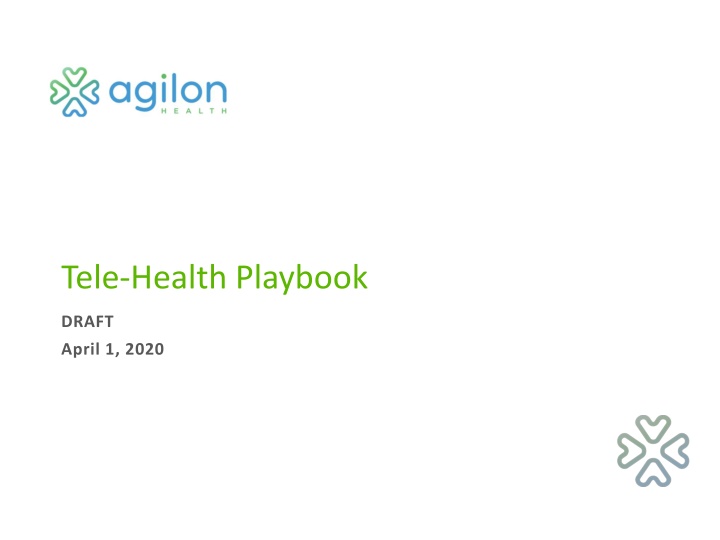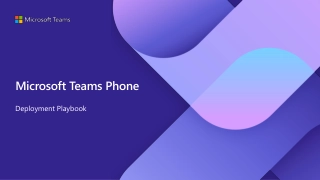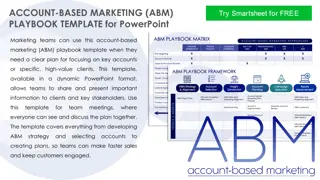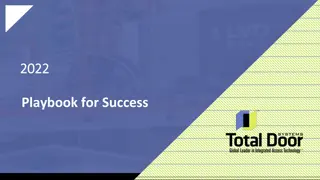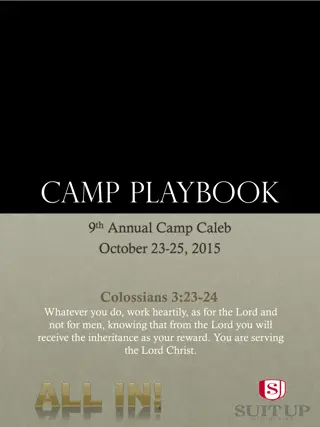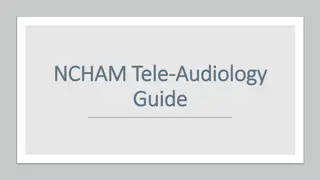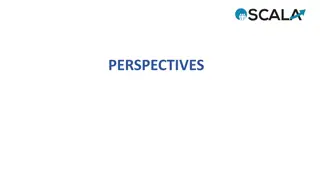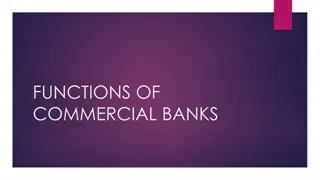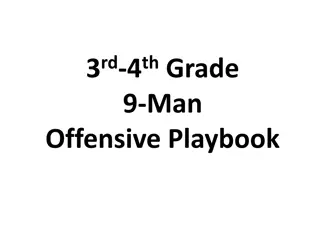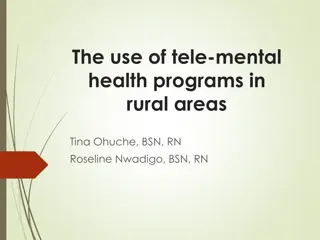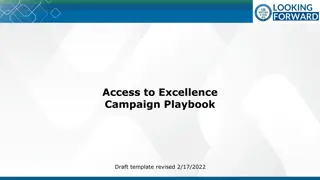Tele-Health Playbook Overview
This draft playbook provides valuable information on telehealth services, payment models, Medicare waivers, and virtual check-ins. It details the expansion of telehealth with the 1135 waiver and outlines available services during the COVID-19 pandemic. The document also covers telehealth billing, reimbursement processes, and the necessary requirements for telehealth visits.
Download Presentation

Please find below an Image/Link to download the presentation.
The content on the website is provided AS IS for your information and personal use only. It may not be sold, licensed, or shared on other websites without obtaining consent from the author.If you encounter any issues during the download, it is possible that the publisher has removed the file from their server.
You are allowed to download the files provided on this website for personal or commercial use, subject to the condition that they are used lawfully. All files are the property of their respective owners.
The content on the website is provided AS IS for your information and personal use only. It may not be sold, licensed, or shared on other websites without obtaining consent from the author.
E N D
Presentation Transcript
Tele-Health Playbook DRAFT April 1, 2020
EXPANSION OF TELEHEALTH WITH 1135 WAIVER Under this new waiver, Medicare can pay for office, hospital, and other visits furnished via telehealth across the country and including in patient s places of residence starting March 6, 2020. Three types of Virtual Services Telehealth visits (E&M and AWVs) Virtual Check-ins E-visits NOTE: Newly Approved Telephone (Audio only) visits 3
Telehealth Services (E&M and AWV) Available nationally only during Pandemic/Declared State of Emergency relating to COVID 19 CPT codes are the same as used in-office (Place of Service (POS) 11). Documentation, time and/or medical decision-making requirements to support use of CPT code are comparable to standards for in-office use. Designate place of service as (POS 11) for services provided when patient is remote; need to apply 95 modifier. Both audio and visual capabilities for real time communication are required to be used for these visits. CMS Medicare FFS reimbursement is comparable to reimbursement for in-office services. Actual reimbursement from Medicare Advantage plans may vary. Some plans have waived all cost sharing related to telehealth services. In other cases, we have not confirmed that, and normal patient co-pays may apply. For example, Aetna, Humana, & MediGold have waived all patient copays; UHC has not. UHC has only waived patient co-pays for e-Visits & Virtual Check-Ins, described below. Refer to list of patient copays by plan by market in the agilon health Connected Community. Continued 4
Telehealth Services (E&M and AWV) continued We believe that ICD-10 codes that normally risk adjust and are included on the claim will be considered by CMS for risk-adjustment purposes. Appropriate ICD10 codes will also be included in calculation of agilon health Physician Quality Incentive programs. On Approved CMS List For Risk Adjustment 2/21/2020 YES YES YES YES YES YES YES YES YES YES YES YES YES YES YES YES YES YES YES Code from CMS' Telehealth Services List CY 2020 99201 99202 99203 99204 99205 99211 99212 99213 99214 99215 99231 99232 99233 99307 99308 99309 99310 G0438 G0439 AWV only codes G0438 and G0439 should be used Description Office/outpatient visit new Office/outpatient visit new Office/outpatient visit new Office/outpatient visit new Office/outpatient visit new Office/outpatient visit est Office/outpatient visit est Office/outpatient visit est Office/outpatient visit est Office/outpatient visit est Subsequent hospital care Subsequent hospital care Subsequent hospital care Nursing fac care subseq Nursing fac care subseq Nursing fac care subseq Nursing fac care subseq Ppps, initial visit Ppps, subseq visit Office new and established visits and follow up detailed CPT telehealth listed 5
Virtual Check-Ins Since 2019, Medicare pays for virtual check-ins for patients to connect with their doctors without going to the doctor s office. However, effective as of March 30, 2020, CMS has adjusted the requirements to include: Eliminate patient initiated requirement & established patient requirement from the historical rules. The communication must not be related to a related E/M services provided within the previous 7 days and not lead to an E/M service or procedure within the next 24 hours (or soonest appointment available) 5-10 minutes of medical discussion Some plans have waived all cost sharing related to Virtual Check-In services (we have confirmed this with MediGold, Aetna, UHC, Humana). In other cases, we have not confirmed that, and normal patient co-pays may apply. These visits can be performed using just telephone (no video requirement). The services may be billed using CPT codes G2012. Average national CMS reimbursement for this code is $14.80. Actual reimbursement from Medicare Advantage plans may vary. Must be used by a physician or other qualified health care professional who can report evaluation and management (E/M) services. 6
E-Visits New in 2020 (regardless of the COVID19 pandemic), CMS introduced six new CPT codes for e-Visits, providing more opportunities for physician practices to be reimbursed for conducting digital health assessments and evaluations for their patients. The 2020 Medicare Physician Fee Schedule describes e- Visits as non-face-to-face patient-initiated digital communications that require a clinical decision that otherwise typically would have been provided in the office. The descriptors further suggest that the codes are intended to cover short-term ( up to seven days ) evaluations and assessments that are conducted online or via some other digital platform, and likely also include any associated interpretation and clinical decision making. Evaluations and assessments that extend beyond the seven-day maximum may constitute remote patient monitoring. Similar to that with Virtual Check-Ins, CMS has changed certain requirements effective The patient must: generate the initial inquiry (although providers can educate beneficiaries regarding the availability of the service prior to initiation) through the practice portal. {NOTE: QUESTION OUT TO DETERMINE WHETHER THIS REQUIREMENT IS BEING WAIVED} verbally consent to receiving e-visit services (consent needed just once per annum) During the pandemic, service is available for new and established patients. Communications can occur over a 7-day period 7
E-Visits (continued) The services may be billed using CPT codes 99421-99423 and HCPCS codes G2061-G2063, as applicable The final code descriptors, and CMS national average reimbursement rates, for the new e-visit codes are as follows. Note that actual reimbursement from Medicare Advantage plans may vary. HCPCS code G2061: Qualified nonphysician healthcare professional online assessment and management, for an established patient, for up to seven days, cumulative time during the 7 days; 5-10 minutes. CMS National Average Reimbursement: $12.27 HCPCS code G2062: Qualified nonphysician healthcare professional online assessment and management service, for an established patient, for up to seven days, cumulative time during the 7 days; 11-20 minutes. CMS National Average Reimbursement: $21.65 HCPCS code G2063: Qualified nonphysician qualified healthcare professional assessment and management service, for an established patient, for up to seven days, cumulative time during the 7 days; 21 or more minutes. CMS National Average Reimbursement: $33.92 CPT code 99421: Online digital evaluation and management service, performed by physician or professional who can bill for traditional E&M services, for an established patient, for up to 7 days, cumulative time during the 7 days; 5-10 minutes. CMS National Average Reimbursement: $15.52 CPT code 99422: Online digital evaluation and management service, performed by physician or professional who can bill for traditional E&M services, for an established patient, for up to 7 days, cumulative time during the 7 days; 11-20 minutes. CMS National Average Reimbursement: $31.04 CPT code 99423: Online digital evaluation and management service, performed by physician or professional who can bill for traditional E&M services, for an established patient, for up to 7 days, cumulative time during the 7 days; 21 or more minutes. CMS National Average Reimbursement: $50.16 Some plans have waived all cost sharing related to e-Visit services (we have confirmed this with MediGold, Aetna, UHC, Humana). In other cases, we have not confirmed that, and normal patient co-pays may apply. 8
[NEW] Audio Only Visits Effective 3/31/2020, CMS is covering telephone only services that were previously non-covered by Medicare. The only evaluation and management services that may be provided to Medicare beneficiaries via audio only technology are shown below. {NOTE: WE ARE WORKING WITH OUR CONSULTANTS IN DC TO UNDERSTAND CMS REIMBURSEMENT FOR THESE CODES} Continued 9
[NEW] Audio Only Visits (continued) 99441 Telephone evaluation and management service by a physician or other qualified health care professional who may report evaluation and management services provided to an established patient, parent, or guardian not originating from a related E/M service provided within the previous 7 days nor leading to an E/M service or procedure within the next 24 hours or soonest available appointment; 5-10 minutes of medical discussion 99442 Telephone evaluation and management service by a physician or other qualified health care professional who may report evaluation and management services provided to an established patient, parent, or guardian not originating from a related E/M service provided within the previous 7 days nor leading to an E/M service or procedure within the next 24 hours or soonest available appointment; 11-20 minutes of medical discussion 99443 Telephone evaluation and management service by a physician or other qualified health care professional who may report evaluation and management services provided to an established patient, parent, or guardian not originating from a related E/M service provided within the previous 7 days nor leading to an E/M service or procedure within the next 24 hours or soonest available appointment; 21-30 minutes of medical discussion 98966 Telephone assessment and management service provided by a qualified nonphysician health care professional to an established patient, parent, or guardian not originating from a related assessment and management service provided within the previous 7 days nor leading to an assessment and management service or procedure within the next 24 hours or soonest available appointment; 5-10 minutes of medical discussion 98967 Telephone assessment and management service provided by a qualified nonphysician health care professional to an established patient, parent, or guardian not originating from a related assessment and management service provided within the previous 7 days nor leading to an assessment and management service or procedure within the next 24 hours or soonest available appointment; 11-20 minutes of medical discussion 98968 Telephone assessment and management service provided by a qualified nonphysician health care professional to an established patient, parent, or guardian not originating from a related assessment and management service provided within the previous 7 days nor leading to an assessment and management service or procedure within the next 24 hours or soonest available appointment; 21-30 minutes of medical discussion 10
AWV Informational Sheet
Before Telehealth Visit Occurs: Provider Check-list If performing visit from home, ensure you are in a private setting If working remotely, request MIP (Member Information Profile) to be emailed the day before the visit Test webcam Test microphone and speakers Test sharing of screen and be prepared to share screen when appropriate Have support team information accessible Turn off all notifications (email, calendar and direct messaging)
Guidance/Checklist for Patient Each practice may want to customize / modify for their own needs and share with patients before visits Set up camera at eye level Turn off notifications Test microphone and speaker Test sharing your screen so during the visit you can share screen if prompted Take visit in a quite room If possible, have a family member or someone with you to help take notes or ask questions Take blood pressure and write down reading Weigh yourself and write down your weight Have a list of your medication including dosage and frequency Write down any updates to your family medical history Have a list of all of your healthcare providers and suppliers List any questions you may have for the doctor Complete HRA electronically prior to visit (see provider s website) Be prepared to review or fax/mail in advance
Telehealth Annual Wellness Visit Best Practices (1 of 3) Before visit, MA/nurse should call patient and complete components under the Non-Physician column Confirm patient has video capabilities and help connect to the physician Component of AWV Non-Physician Prior to telehealth visit with physician Physician Provide to patient prior to the visit for completion through portal or mail hard copy to patient If mailed to patient, provide SASE for patient to return prior to visit MA or nurse review with patient prior to the telehealth visit Health Risk Assessment Acknowledge review of HRA in visit note List of Current Providers and Suppliers MA or nurse to review with patient and document or update in EMR prior to visit Pull forward in note Establish Medical and Family Health History Document patient s medical history, social history, family medical history, and current medications and supplements Pull forward in note Use height from prior visit If patient has a scale, ask them to weigh themselves and report verbally If patient has BP cuff, ask them to self-report latest reading Note that all vital signs were self reported by patient. If patient does not have scale and/or BP cuff, note that equipment is not available and can not be obtained during this visit Measurements (Height, Weight, BMI and BP) Recommend assessing BP control if no reading available
Telehealth Annual Wellness Visit Best Practices (2 of 3) Component of AWV Non-Physician Prior to telehealth visit with physician Physician Cognitive Impairment Assessment Ask 2 screening questions. If both questions are negative then no further testing needed. Is there evidence of cognitive impairment that is implied? Has the family member stated there is evidence of cognitive impairment? If either is positive note for provider to administer SLUMS exam. Ask patient to have a pen and paper ready. If either screening question was positive, administer and document SLUMS exam. Ask patient to draw a circle and put the hour markers and the time at ten minutes to eleven o clock Complete other questions on exam Risk factors for depression, or other mood disorders If patient has no prior diagnosis of depression, administer PHQ-2. If PHQ-2 is positive, administer PHQ-9. Review and document PHQ results and note treatment or referral as needed. Administer a falls risk assessment Ask patients about their ability to perform ADLs Ask patient about hearing impairment Review functional ability and level of safety Acknowledge review of functional ability and level of safety through documentation Establish appropriate written screening schedule After physician completes, print and mail the written screening schedule to the patient Document a written screening schedule or checklist for age-appropriate preventive services and recommendations from USPSTF and ACIP. Document that screening schedule will be mailed to patient or sent electronically
Telehealth Annual Wellness Visit Best Practices (3 of 3) Component of AWV Non-Physician Prior to telehealth visit with physician Physician Advance Care Planning services If Advanced Directive is not in place, mail information along with the personalized health advice If Advanced Directive available from prior visit, bring forward and document any changes Establish or update list of risk factors and conditions for which interventions are recommended or under way Document: Mental health conditions including depression, substance use disorder, and cognitive impairment Risk factors or conditions identified Treatment options and their associated risks and benefits Furnish personalized health advice and appropriate referrals to health education or preventive counseling services or programs After physician completes, print and mail the plan of care to the patient Complete plan of care and document what is due. Include referrals to educational counseling services or programs aimed at: Community-based lifestyle interventions to reduce health risks and promote self- management and wellness including: Fall prevention Nutrition Physical Activity Tobacco Use cessation Weight Loss
Coding and documentation of telehealth visits Documentation requirements and standards will still apply to telehealth visits. ICD-10 Official Coding and Reporting Guideline: The assignment of a diagnosis code is based on the provider's diagnostic statement that the condition exists. The provider's statement that the patient has a particular condition is sufficient. Code assignment is not based on clinical criteria used by the provider to establish the diagnosis. Avoid non-definitive terms such as: probable, consistent with, likely, suspected when there s a definitive diagnosis For vitals it s acceptable for providers to obtain vitals from patients and when it can t be obtained, it just needs to be documented as unattainable and the reason, example: patient does not have blood pressure cuff Avoid documenting patient reports x condition , when x condition has been confirmed. A coder can only code a diagnostic statement made by the provider.
Operations Setting up Telehealth Processes
OPERATIONAL CHECKLIST FOR SETTING UP TELEHEALTH Determine location for telehealth at home and/or office Determine what device(s) will be used for telehealth Determine what software platform(s) will be used Prep the patient about the visit and mechanics of setting up on their end for the first telemedicine visit, including getting consent Identify scheduling parameters and determine who will schedule visits Determine involvement of members of the care team in telehealth Determine documentation parameters in the EMR and billing Train providers and staff on telehealth processes and protocols 1. 2. 3. 4. 5. 6. 7. 8. 20
1. Location If at home Assess bandwidth (Wi-Fi or hardwire connection) Does the provider have access to the EMR? How will other members of the care team participate in provider at- home telemedicine (e.g. nurses initiating the visit, doing vitals, medication reconciliation, history of chief complaint, and blood pressure)? If at office Assess bandwidth (Wi-Fi or hardwire connection) Determine a private location within the office 21
2. Device(s) used for telehealth Generic office iPad Office laptop with camera Provider devices Note that the practice decision on location (office or at home) will also affect the choice on device. 22
3. Software Platform Identify software platform(s) to be used, for example: Doxy.me EMR video visit FaceTime Zoom Skype 23
4. Prep Patients for the Visit, Mechanics, and Set Up Example scripts on the Connected Community https://agilonhealth.connectedcommunity.org/viewdocument /sample-scripts-for-outreach-to-pati Make sure the patient has technology platform downloaded on their device ahead of visit Communication to patient to minimize disruption send reminder with instructions ahead or add to portal Advice patient to update phone/tablet operating system Make sure patient is in an area with good reception, ideally Wi-Fi (remind them if not on Wi-Fi, mobile data charges may apply) Have an SOP for technical disruptions 24
5. Scheduling Parameters Determine time for visit (30 min recommended) Place on schedule live visits or e-visits Include personalized link for PCP (if Doxy.me) Scheduler reminders (and see previous slide): Make sure patient has a smartphone/tablet with video capabilities Tell patient to be in a quiet & private area with access to Wi-Fi (or be prepared to use data if not) Remind patient to check in 15 minutes before the video visit, especially if you have a dedicated platform with check-in features Be prepared to have a credit card on hand in case a co-pay is assessed before the visit. Determine scheduling protocol if provider is working from home to just do telehealth visit 25
6. Involvement of the Care Team Nurse initiates visit, gets vitals, medication reconciliation, history of chief complaint, and BP, then hands off to PCP. Vitals can be patient derived Temperature- they can take temp and tell you Weight they can weigh themselves Respiration observe on video Document as normal for visit type and indicate patient gave permission (where necessary) for telehealth visit Review of past records, including labs is key on E&M Level of Service Pass visit back to Nurse to complete visit as normal for check out, scheduling Have an SOP for technical disruptions Remember: If a patient is not checked in within 2 min of their appointment time, have someone call them. 26
7. Documentation and Billing Code for the visit as if the patient was in front of you Modifications to the billing code may be automatically be made on the back- end, or you may need to enter them yourself: The Place of service billed should be Telehealth POS-02. Medical record documentation must support the service billed. During the national emergency, you can bill encounters for Medicare follow-up visits. New patient visits for Medicare will not be audited. You can see New Patients, but the missing exam portion reduces billing level. Coinsurance and deductible amounts required under the plan design should be collected, absent a waiver of such by the plan. Most practices will send bill to patient for their responsibility as normal workflow Co-Pay is often collected from the patient at time of check-in (depending on the video solution used). If the patient is self-pay, the patient may be asked to pay a flat fee, depending on your practice. Your practice director can answer whether and how much your office charges for self-pay video visits. 27
7. Documentation and Billing (continued) You can bill by time: Document >50% of the visit was spent counseling patient or coordinating care for Dx xyz): >15 min = level 3 follow-up, >25 min = level 4, >40 minutes = level 5, just like with a regular visit By complexity: e.g. level 4: History, Detailed: Extended history of present illness (HPI) (4+ elements or status of 3 chronic conditions) Extended review of systems (ROS) (problem pertinent 2-9 additional elements) and Pertinent past, family and/or social history (1 element) Exam, Problem Focused: Limited exam of the affected body area or organ system MDM, Moderate Complexity: Multiple number of diagnoses or management options (3 diagnoses) Moderate amount of complexity and/or data to be reviewed (3 elements) and Moderate risk of complications and/or morbidity and mortality (Mild exacerbation of chronic illness / 2 stable chronic illness, undiagnosed new problem, acute illness with systemic symptoms, 1 acute uncomplicated injury, prescription drug management) 28
8. Train providers and staff Identify existing videos or training modalities to operate the software Train on aforementioned processes and protocols for operation of video visits 29
Conduct Virtual Visit Able to Successfully Connect w/ Tele-Health Platform? No Yes Does patient have an iPhone or Android? Follow Telehealth Procedure to see Pt. iPhone Android Call the patient w/ *67 in front of their number. Once the patient answers convert to facetime to complete visit. Call patient using *67 or software. Continue to treat patient as best as possible. Chart in EHR Completed
Conduct Visit via Tele-Health Able to Successfully Connect via Software No Yes Does patient have an iPhone or Android? Via Telehealth Platform iPhone Android Document as you would an in-office visit Change location to WH Virtual Clinic Select appropriate E/M or visit code CBO will add telehealth modifier Facetime or telephonic call Telephonic call or other video chat modality Document as you would an in-office visit Change location to WH Virtual Clinic Document change in modality Select appropriate E/M or visit code CBO will add telehealth modifier Complete
Tips During the Visit Shared by Dr. Tamler on 3/23
Preparing for the Visit Make sure the door to the room where you are conducting the telehealth visit is closed Ensure you have solid Wi-Fi connection Wear professional attire, i.e. a white coat Create the atmosphere of a regular in-person visit, e.g. if you ordinarily wear a stethoscope around your neck, you should do so during the video visit as well Ensure there is no clutter in the field of vision of the camera (you can have clutter right in front of you, the camera should not pick it up) Check the background behind you does it look professional? 34
Tips During the Visit Smile! You're on camera! You just made your patient s life much better by saving them a trip to the doctor. The visit is typically NOT being recorded, but duration of video call may be recorded. Your practice manager will know about your platform. Introduce yourself Confirm patient name and date of birth What state is the patient in? What state are you in? Document in your note that this is a telehealth visit Who else is present (Patient? Family members?) 36
Tips During the Visit (continued) Your iPhone or iPad will be next to your desktop. This means that whenever you are documenting on your workstation or reviewing data, your patient will feel like you are looking away from them Acknowledge this by narrating what you are doing: I am looking away from the camera to check your latest labs You can document part of the exam by inspection, but it will inevitably be more cursory than an in-person visit would permit You can document patient-derived vital signs (e.g. weight, bp) but should comment that the source is the patient. Be prepared for video visits to be shorter / more focused than in- person visits, and there is no wait for assessment of vital signs. Remote monitoring data (e.g. continuous glucose monitoring) can be discussed via telehealth (and billed with modifier 25). Send your recommendations (e.g. after visit instructions) to the patient via portal or secure email 37
General Recommendations Go through your visit the way you normally would: HPI: Try to get 4+ components Don t forget ROS MedRec: If the patient is seeing you from home, have them show you their medicine cabinet and/or meds on their night stand Don t forget to review SH/FH Try to document same complexity as you would in person 38
Physical Exam You can document quite a bit by inspection: Constitutional: well-nourished, well-developed, well-appearing Ears, nose, mouth, throat: normocephalic, atraumatic, external ears normal by inspection Eyes: no proptosis, extra-ocular eye movement intact, nl sclerae, conjunctivae not injected Neck: No visible goiter, range of motion of neck appears normal Respiratory: No increased respiratory effort Cardiovascular: Chest/Breast Gastrointestinal: No caput medusae Genitourinary Lymphatic Skin: no visible rash, no foot ulcers, no varicose veins Psychiatric: non-anxious, normal affect 39
Ask the Patient to be your Assistant Have the patient step on their home scale Do they have a home bp monitor? Do they know how to obtain their own HR? Most patients have their own thermometer Patients can depress their own shins to determine extent of edema Have the patient position their phone in ways to help you: Diabetes: Have the patient put the camera on the floor and show you the bottom of their feet Top of scalp Nape of neck (acanthosis) Close-ups of body areas that trouble them If the patient has a stand for their device, you can provide instructions for adduction / abduction of extremities etc. 40
TeleHealth Etiquette Telehealth Etiquette: Good Screenside Manners for Successful Consults https://vimeo.com/357926266 42
Sources Dr. Ronald Tamler presentation on Virtual Visits Tam Pham presentation on Virtual AWVs Agilon legal-approved guidance on Telehealth billing and coding Examples, workflows and other promising practices shared from agilon markets More resources on the agilon Connected Community 43
